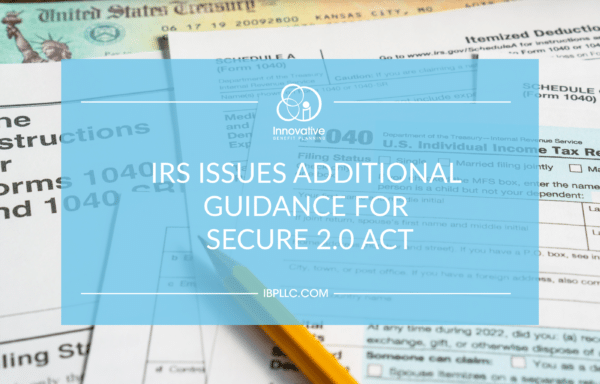In an effort to provide necessary clarity for employers and plan sponsors, the Internal Revenue Service (IRS) issued long-awaited guidance for various provisions under the SECURE 2.0 Act (SECURE 2.0). This guidance comes in Question-and-Answer format and addresses twelve of the 90+ provisions under SECURE 2.0. Specifically, provisions related to de minimis financial incentives and employer Roth contributions were among the sections addressed up this guidance.
De Minimis Financial Incentives
Section 113 of SECURE 2.0 is related to financial incentives that may be provided to individuals for contributing to the employer’s 401(k) plan. Prior to SECURE 2.0, employers were prohibited from offering plan participants immediate financial incentives, such as a gift card, to incentivize the individual to participate in the plan in order to boost overall participation. SECURE 2.0 modified this longstanding rule to enable plan sponsors to provide a de minimis financial incentive to employees who elect to begin deferrals to the plan, so long as the incentive is not paid for by the plan. Section 113 is applicable to both 401(k) and 403(b) plans and was effective as of the signing of SECURE 2.0.
The updated guidance states employees that already have a deferral election in effect are unable to receive this type of incentive. Further, the guidance specifies that matching contributions are not de minimis financial incentives and such an incentive is not treated as a plan contribution, rather the incentive should be treated as taxable wages to the individual. Finally, the guidance confirms that, for the purposes of Section 113, de minimis means $250 or less in value.
Employer Roth Contributions
Section 604 of SECURE 2.0 amends current law (which required matching contributions be made on a pre-tax basis only) to allow for defined contribution plans to provide participants with the option to receive matching contributions on a Roth basis. This Section of SECURE 2.0 was effective as of the Act’s signing; however, plan sponsors may have been hesitant to implement the change prior to receiving additional guidance from the IRS.
The updated guidance provides the necessary information should a plan sponsor opt to move forward with this plan design change. Among other things, the guidance addresses the following:
- A matching or nonelective contribution designated as a Roth contribution is includable in the individual’s gross income for the taxable year in which the contribution is allocated. With that said, designated Roth matching and nonelective contributions that are made to a qualified plan are excluded from wages for the purposes of federal income tax withholding, FICA taxes and FUTA taxes. Employees should be mindful of this when determining whether an increase to withholding or estimated tax payment should be made to avoid a potential underpayment penalty.
- Designated Roth matching and nonelective contributions must be reported using Form 1099-R for the year in which the contributions are allocated.
- A matching contribution may only be designated as a Roth contribution if the employee is fully vested at the time the contribution is allocated.
- An employee may be permitted to designate an elective contribution as a Roth contribution without being permitted to designate a matching or nonelective contribution as a Roth contribution, and vice versa. Roll over to another designated Roth account or Roth IRA is permitted, subject to specified requirements.
- For the purposes of Code Section 415, Roth matching and non-elective contributions are not included in the safe harbor definition of compensation as these contributions are not included in wages.
The guidance also provides for a one-year extension for plan amendments in light of the legislative changes and need for further guidance for other provisions under SECURE 2.0 provided that: 1. The amendment is adopted no later than the last day of the first plan year beginning on or after January 1, 2025; 2. The plan is operated as if the amendment were in effect as of the effective date of the provision under SECURE 2.0 through either the extension date or date in which the amendment is adopted; and 3. The amendment applies retroactively to the effective date of the SECURE 2.0 provision per the statute.
Despite the general extension for plan amendments, plan sponsors should begin, if they have not done so already, reviewing their plan documents and discussing with their payroll providers and plan administrators how to implement the changes, both mandatory and discretionary, under SECURE 2.0. Special attention should be directed toward provisions of SECURE 2.0 with effective dates prior to the 2024 plan year as some amendments may need to apply retroactively.
The Treasury Department and IRS have requested comments and suggestions regarding several of the provisions addressed in the guidance and will publish the comments to its public docket. The full guidance can be found here, with further guidance anticipated on other provisions under SECURE 2.0 in the coming months. For additional information or assistance, please contact the Innovative team at resources@iifria.com.












